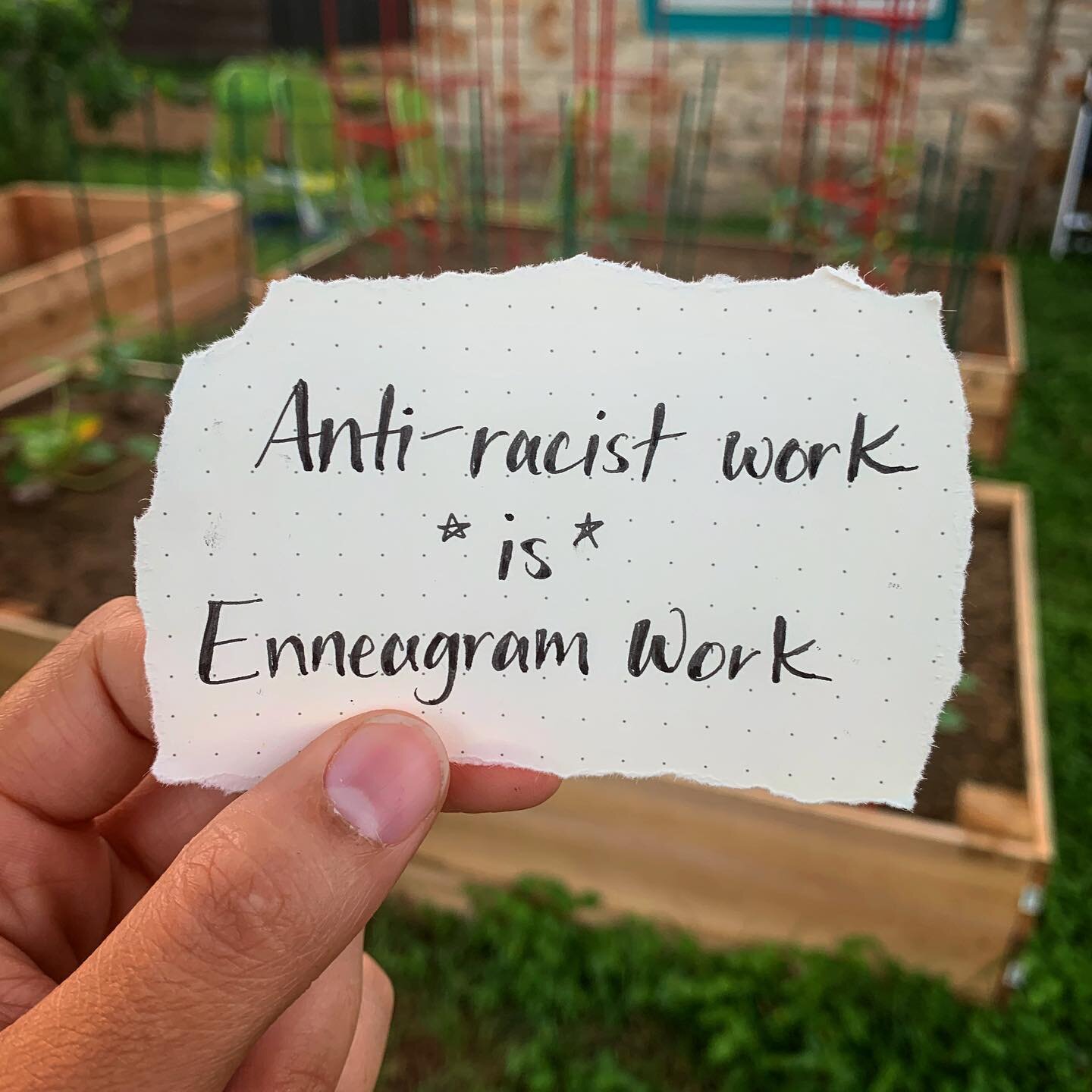This Moment, Anti-Racism, & the Enneagram
With the current social unrest and the important, ongoing conversations, protests, and other action taking place to combat systemic racism and the police brutality it perpetuates, I felt it was out of step to my continue daily posts of "The 100 Days of Enneagram" project for a time. So I paused my daily updates in an effort to #amplifymelanatedvoices on my online platforms and to be available for the sort of listening, learning, and work I must do right now to better participate in the fight for justice. I’m glad I did.
That said, I don’t believe Enneagram work is separate from this fight. In fact it can be an integral tool in our much needed personal, communal, and societal transformation. And I think it’s important that we start talking about that explicitly.
360º Theory
If you’ve heard me teach, you know my “360º theory.” In short, if we picture the Enneagram symbol in 3D and we all stand on the point of our dominant type while viewing an object placed in the center of the circle, we each see only about 40º of that object clearly. While we may move around the circle at times to access our wings and resource points, our habitual, patterned responses to reality land us most often on that dominant point. As a result, we get really good at seeing that 40º clearly and may entirely miss what someone else is seeing on the other side of the circle. The natural conclusion? We actually need all 9 perspectives to get a complete, holistic picture of anything.
This is a simple illustration that scales, with potentially extensive consequences. If we really believe this, then we can begin to value difference and prioritize the inclusion of varying perspectives. We can grow in compassion for and patience with each other’s experiences––asking better questions like, “What are you seeing that I’m not seeing?” rather than jumping straight to, “You’re wrong!” or “You’re crazy!” when we encounter disagreement. The Enneagram offers us language with which we can translate each other’s stories in ways that help us understand more fully, connect more deeply, and live together more equitably. I see the Enneagram as a framework through which we can explore the endlessly complex and nuanced nature of our identities.
Because of course there are more than 9 cookie-cutter ways of being in the world. There are technically 108 Enneagram types when you account for all the various combinations of wings and stacking of our instinctual variants. But beyond that we bring our life experiences, cultural contexts, and all our intersectional identities to bear on what we call our Enneagram type. There is infinite diversity within our patterns of being and so much yet to be explored, as the modern Enneagram of personality is only about 50 years young.
Intersectionality
But the Enneagram world––like so much of the world at large––is centered around white, cisgender, heteronormative, middle-to-upper class privilege and the influence of Western Christianity. Though, like so many other wisdom teachings that have been co-opted by empire, the Enneagram didn’t originate from that center of power. Sadly, I heard a prominent Enneagram teacher insist just 2 weeks ago that since “Enneagram wisdom has taught us that there are nine ways of seeing and nine ways of processing what we see,” we would not be having the conversation that our learning community requested about how to build a safer, more inclusive space for the LGBTQ+ and people of color in our group. As if intersectional identities of race, ethnicity, sexual orientation, gender, and religious or spiritual identities are irrelevant and could be compartmentalized outside of our Enneagram experience? As if we could have “an Enneagram focused” community that didn’t allow diverse voices to express how the dominant narratives exclude or harm them?
No, not anymore. I left that community.
I’m not interested in “Enneagram only” education, because there is no such thing. Reality cannot be siphoned like that. My type 8 friend and refugee from Laos is embodying a different expression of 8ness than is my non-binary 8 friend from the midwest, than is my Black 8 friend in Tennessee, than is a white, conservative Christian 8 I know from the buckle of the Bible belt. The last of those experiences is over-represented in Enneagram dialogue today, while the others are under-represented. This needs to change. And it’s not only a justice issue for racial minorities and other marginalized peoples––we’re all missing out when there are voices absent from the conversation. To get the whole picture, we need everyone’s point of view. Remember?
Anti-Racism
As my friend and colleague, Abi Robins, said recently:
Photo by Abi Robins, Conscious Enneagram
“The Enneagram is not meant to be engaged with for its own sake. This isn’t some fun thought experiment we can play with and then set down. It is designed to give us the tools we need to live our lives in a new and more meaningful way.
••
The Enneagram gives us the tools to be fully grounded in our lives and in our cultural moment. Which, in our particular moment, means seeing, acknowledging, accepting, and working to change, the effects of white supremacy in our country and the world.
••
Just as we discover the unconscious patterns of our type through nonjudgmental self-observation, we must also become aware of how we unconsciously participate and benefit from the systematic racism and anti-blackness that has been shaping the world for centuries.
••
Clearly, I’m talking to white people here. My people. If your Enneagram work isn’t leading you into anti-racist and social justice work, you’re not doing Enneagram work. Full stop. If your spiritual experience isn’t directly moving you to stand up and fight for those who are most vulnerable and most oppressed, it’s not a spiritual experience. It’s spiritual bypassing.”
Commitments
It’s time to deconstruct the institution of white supremacy and decolonize the traditions it has subsumed––including the Enneagram. For more on what that means and what it could look like I point you to this important conversation: THE ENNEAGRAM IS NOT JUST FOR WHITE PEOPLE: Decolonizing the Enneagram with Micky ScottBey Jones.
Here are some of the commitments I am making as I reengage with public work:
Following and promoting more BIPOC* Enneagram teachers**
Continuing to diversify my source materials and teachers
Continuing to prioritize inclusion of diversity in recommendations I share
Having and sharing conversations with BIPOC friends and colleagues***
Always admitting when I get things wrong, being willing to do the work of making amends, and learning how to do better
Continuing my personal work, practices, education, and therapy
Making sure that inner work leads to and supports direct anti-racist action
Always remaining open to feedback, critique, accountability, and questions
Never moving so fast that I can’t maintain mindfulness, care, consideration, and compassion
*BIPOC = Black, Indigenous, and People of Color
**Teachers like Chichi Agorom (Thin Spaces Co.), Leanette Pokuwaah (Enneastories and Enneagram in Color), Micky ScottBey Jones, Jessica D. Dickson, Coach Milton Stewart (Do It for the Gram Podcast), etc.
***Many of these conversations were already planned but will happen gradually, as I especially do not want to ask for more emotional and intellectual labor from these people at this time––especially when I am not able to adequately compensate financially for that labor. This is a long arc commitment, not just a passing moment. And we’ll continue these valuable conversations over the long haul.
The 100 Day Project
As I start catching up on The 100 Days of Enneagram, I’ll do so with a few new parameters. Primarily, each post will be closer to 5 minutes long, not exceed 10 minutes. I’m not comfortable taking more than 5-10 minutes of your time each day right now; there are voices much more important to center than mine right now. Though as I have almost 3 weeks to catch up on, I may post more than one per day and invite you to explore at whatever pace is best for you.
I’m glad to jump back in continuing with our “Enneagram Creativity” series. Creativity relies on imagination, and imagination is intimately connected to hope. We are in desperate need of the imagination that can fuel us in creating new systems, new relationships, new laws, and new societal structures. And we will not make it through that process without hope. So I think this look at the intersection of the Enneagram with creativity is as relevant as ever.
Jericho Brown, Shreveport-native and Pulitzer Prize winning poet, says it this way:
“Hope is always accompanied by the imagination, the will to see what our physical environment seems to deem impossible. Only the creative mind can make use of hope. Only a creative people can wield it. ”
And with that in mind, let’s go forward––with hope, imagination, and the commitment to creating a new kind of world––together.

